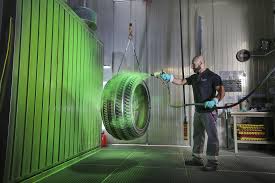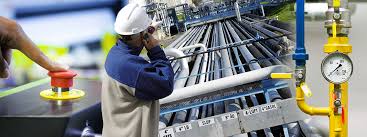Nondestructive testing (NDT) techniques play a crucial role in ensuring the structural integrity and safety of high-rise construction projects in Egypt. With the rapid development of high-rise buildings in urban areas, the use of NDT techniques has become essential to detect potential defects and flaws without causing any damage to the structure. In this paper, we will explore the various nondestructive testing techniques employed in high-rise construction projects in Egypt and their significance in ensuring the durability and safety of these structures.
Nondestructive testing (NDT) techniques are commonly used in high-rise construction projects in Egypt to ensure the safety and structural integrity of buildings. These techniques include ultrasonic testing, radiographic testing, magnetic particle testing, and liquid penetrant testing. They allow for the detection of internal flaws, cracks, and corrosion in construction materials without causing damage to the structure. NDT techniques are essential in ensuring that high-rise buildings in Egypt meet safety standards and regulations, providing peace of mind to occupants and stakeholders. Additionally, NDT helps in assessing the quality of construction materials and workmanship, ultimately leading to better-performing and longer-lasting buildings.
The Importance of Nondestructive Testing in High-Rise Construction in Egypt

Nondestructive testing (NDT) plays a crucial role in high-rise construction in Egypt by ensuring the safety, reliability, and quality of the structures. With the rapid urbanization and construction of tall buildings in Egypt, it is imperative to employ NDT techniques to assess the integrity of materials and components used in construction. NDT methods such as ultrasonic testing, radiographic testing, and magnetic particle testing can detect flaws, cracks, and imperfections in critical structural elements without causing damage to the building. This helps in identifying potential weaknesses before they lead to catastrophic failures, ensuring the safety of residents and occupants. Additionally, NDT in high-rise construction aids in optimizing maintenance and repair strategies, ultimately extending the lifespan of buildings and reducing long-term costs. Overall, the importance of nondestructive testing in high-rise construction in Egypt cannot be overstated in ensuring the structural integrity and safety of these towering developments.
Advantages of Nondestructive Testing for High-Rise Buildings in Egypt

Nondestructive testing for high-rise buildings in Egypt provides several advantages. It allows for the evaluation of structural integrity without causing damage to the building, minimizing disruption to occupants and operations. This type of testing also helps in identifying potential defects and weaknesses in the structure, allowing for proactive maintenance and repairs to prevent future failures. Additionally, nondestructive testing techniques can provide cost-effective and reliable data for assessing the safety and durability of high-rise buildings, helping to ensure the long-term viability of these structures in Egypt's urban landscape.
Nondestructive Testing Techniques for High-Rise Construction in Egypt

Nondestructive Testing (NDT) techniques play an essential role in the construction and maintenance of high-rise buildings in Egypt. These techniques are used to evaluate the structural integrity of buildings without causing any damage to the structure. Some of the commonly used NDT techniques in high-rise construction include ultrasonic testing, radiographic testing, eddy current testing, magnetic particle testing, and visual testing. These techniques allow engineers to assess the condition of concrete, steel, and other building materials, as well as detect any potential defects or weaknesses in the structure. In the context of high-rise construction in Egypt, NDT techniques are particularly crucial due to the country's high seismic activity and the need to ensure that buildings can withstand earthquakes and other natural disasters. By using NDT, engineers can identify any structural issues early on and take corrective measures to ensure the safety and stability of high-rise buildings. Additionally, NDT techniques are also used during the construction phase to verify the quality of materials and workmanship, as well as to monitor the performance of the building over time. This helps in preventing potential failures and ensuring the long-term durability of high-rise structures in Egypt. Overall, NDT techniques are integral to the construction and maintenance of high-rise buildings in Egypt, as they enable engineers to assess and monitor the structural integrity of buildings without causing any damage, ultimately contributing to the safety and longevity of these structures.
Ensuring Structural Integrity: Nondestructive Testing in Egypt's High-Rise Projects
The use of nondestructive testing (NDT) in high-rise projects in Egypt is crucial for ensuring the structural integrity of buildings. NDT techniques, such as ultrasonic testing, radiography, and eddy current testing, are used to detect any defects or weaknesses in the structural components of the buildings without causing any damage. This is particularly important in Egypt, where high-rise construction is common and the safety of these structures is of paramount importance. NDT helps to identify any potential issues in the construction process or the materials used, allowing for necessary corrections to be made before the building is completed. By incorporating NDT into the construction process, developers and builders can ensure that their high-rise projects meet the necessary safety standards and regulations. This not only protects the public and occupants of these buildings but also helps to maintain the long-term structural integrity of the structures, reducing the risk of future failures or collapses. Overall, the use of NDT in Egypt's high-rise projects plays a vital role in ensuring the safety and stability of these buildings, ultimately contributing to the overall infrastructure and urban development in the country.
The Role of Nondestructive Testing in Quality Assurance for Egypt's High-Rise Buildings
ndt destructive testing
Nondestructive testing plays a crucial role in quality assurance for Egypt's high-rise buildings by ensuring the structural integrity and safety of the buildings. It involves the use of various testing methods such as ultrasonic testing, radiographic testing, magnetic particle testing, and visual inspection to detect potential defects or weaknesses in the building materials and components without causing any damage. This helps to identify any issues early on and ensure that the construction meets the required standards and regulations. Additionally, nondestructive testing helps to assess the condition of existing buildings, monitor any changes in their structural integrity, and plan for necessary maintenance and repairs. Overall, the use of nondestructive testing in quality assurance is essential for ensuring the safety and longevity of high-rise buildings in Egypt.
Innovations in Nondestructive Testing for High-Rise Construction in Egypt
Innovations in nondestructive testing (NDT) for high-rise construction in Egypt are crucial for ensuring the safety and integrity of these structures. NDT techniques such as ground-penetrating radar, ultrasonic testing, and thermal imaging are being increasingly utilized to assess the quality of materials, detect defects, and monitor the structural health of high-rise buildings. These technologies help in identifying potential weaknesses or flaws in construction materials, leading to early detection of structural issues and ensuring the safety of these tall buildings. Additionally, innovations in NDT equipment and methodologies are contributing to more efficient and accurate assessment of high-rise construction, ultimately leading to improved quality and sustainability in the built environment.
Challenges and Solutions: Nondestructive Testing in Egypt's High-Rise Development
Challenges in nondestructive testing in Egypt's high-rise development include limited access to advanced technology and expertise, as well as strict regulations and standards. Additionally, the high cost of equipment and training has hindered the widespread adoption of NDT methods. Solutions to these challenges involve collaboration with international experts and organizations to access cutting-edge technology and knowledge. Training and capacity building programs can also help to develop local expertise in NDT. Furthermore, efforts to streamline and update regulations can facilitate the use of NDT in high-rise development projects. Overall, a multi-faceted approach is needed to overcome the challenges and promote the use of nondestructive testing in Egypt's high-rise development.